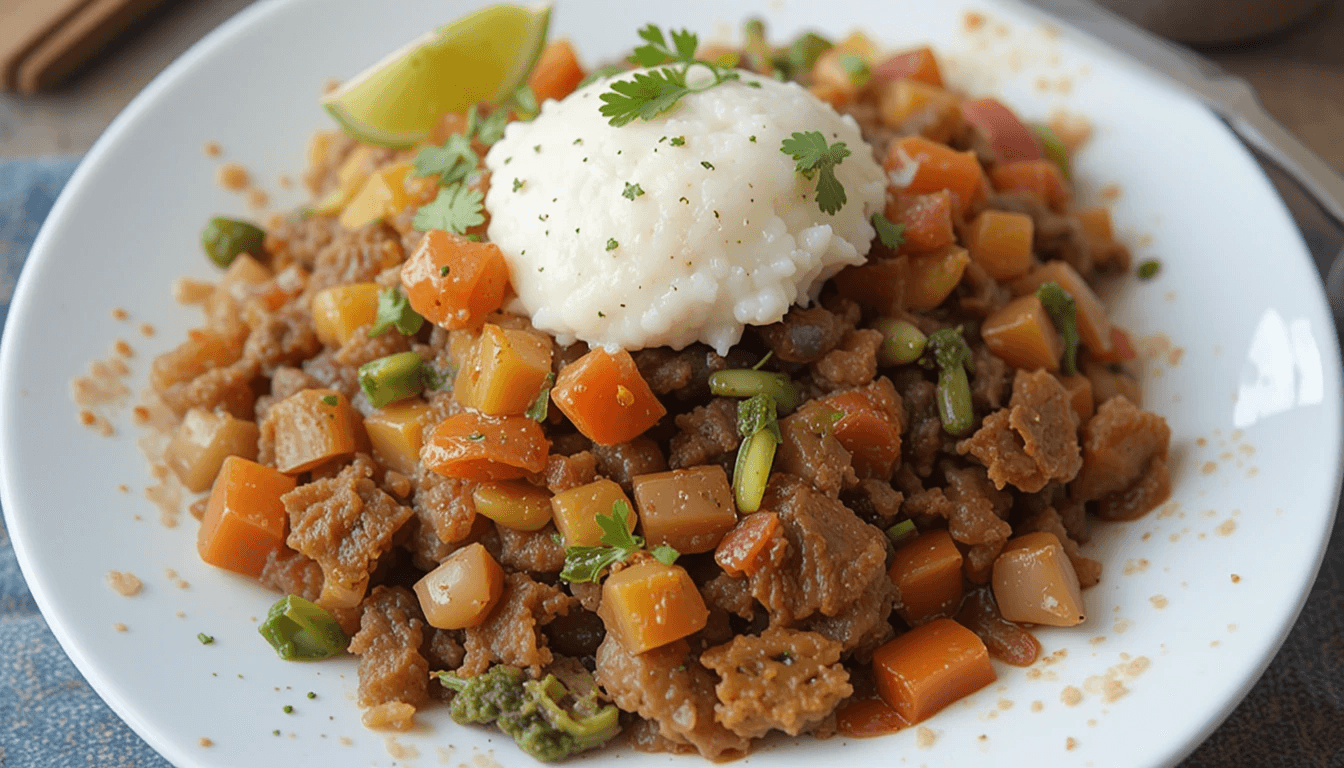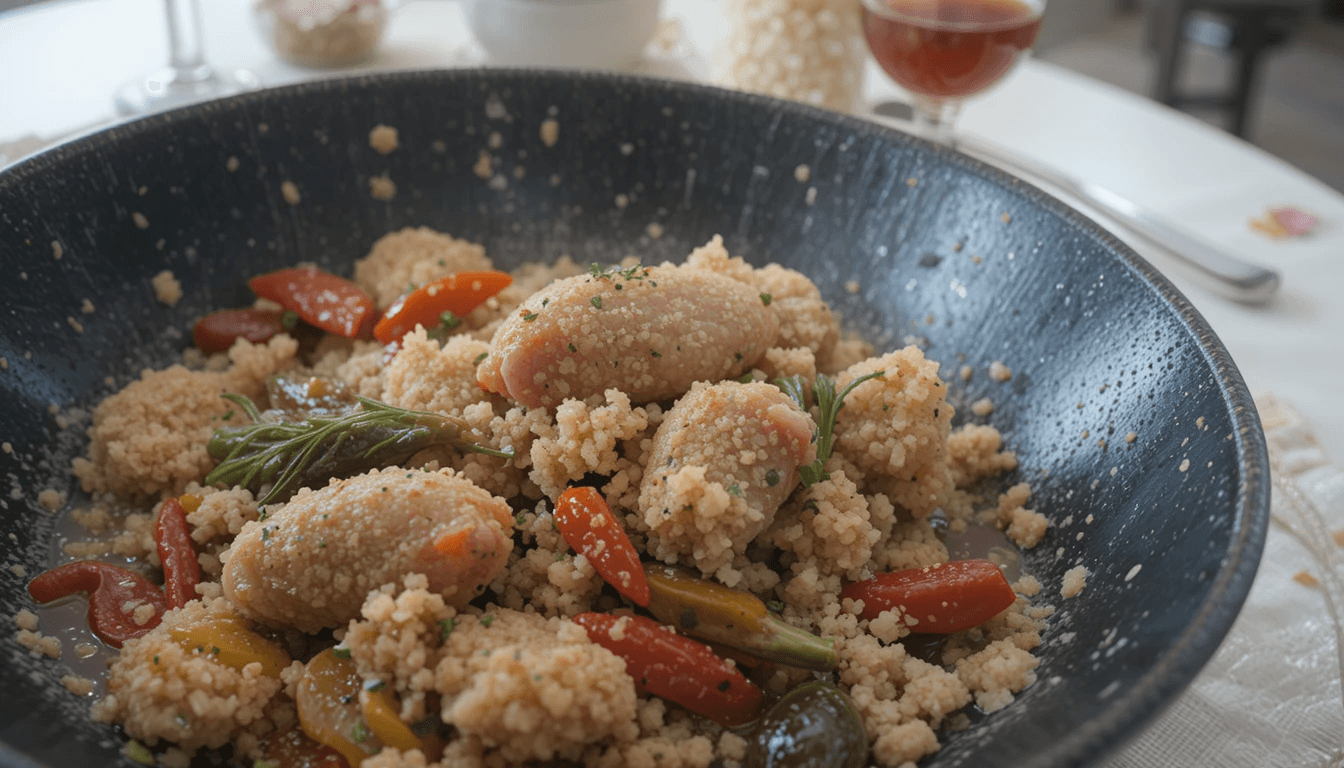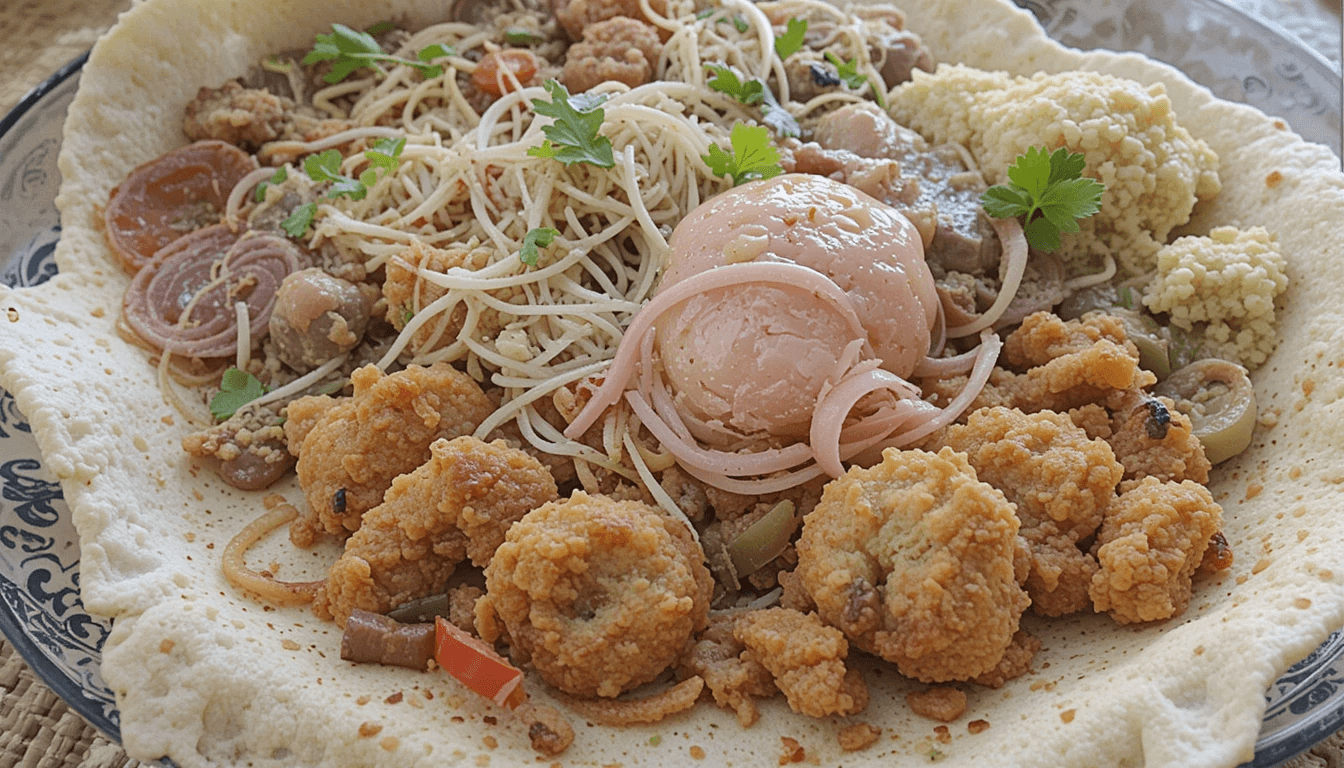Discada Recipe: A Hearty Mexican Skillet Feast is a treasured meal originating from Northern Mexico and cooked in a large circular pan. This discada recipe blends different meats, spices, and vegetables for a unique smoky flavor. It’s often shared at gatherings, where friends and family bond over the communal joy of cooking together.
Introduction
Picture a sizzling pan filled with marinated meats, peppers, onions, and a chorus of spices blending into one joyful aroma.
Now imagine that pan—a large, circular, upcycled farm disc—set over an open flame in someone’s backyard, surrounded by people chatting, laughing, and waiting eagerly to sample the juicy goodness.
That’s exactly the kind of warmth and excitement a discada recipe can bring to your table. Whether you’re hosting a party, hanging out with friends, or just looking for an adventurous new dish to try, preparing a discada recipe transforms an ordinary meal into a memorable event.
Mexican cuisine is rich in both flavor and tradition, and the discada recipe embodies this beautifully. Although it’s best known in Northern Mexico—particularly in states like Chihuahua and Nuevo León—this robust, crowd-pleasing dish has found fans all across the world.
In this article, we’ll explore everything from the history of the discada to the exact steps you need to replicate an authentic discada recipe at home. You’ll gain a deeper understanding of the cooking technique, learn tips for seasoning your disc, and pick up creative ways to customize your meal. Let’s get started on this culinary adventure together!

What Exactly Is a Discada Recipe?
A discada recipe is a preparation method that uses a large, round metal disc—traditionally fashioned from a repurposed agricultural plow disc—to cook an assortment of ingredients over a high flame. The pan (sometimes referred to simply as a “disco”) is often attached to a stand or set over an open fire, making it perfect for outdoor cooking. The result is a dish featuring a savory fusion of meats, vegetables, spices, and occasionally beer or other flavorful liquids.
The Basic Concept of a Discada Recipe
- Multiple Meats: A classic discada recipe typically includes several types of protein such as beef, pork, chorizo, and bacon.
- Fresh Vegetables: Onions, bell peppers, jalapeños, tomatoes, and garlic often appear in discada.
- Seasonings and Sauces: The dish comes alive with spices like cumin, oregano, black pepper, and salt. Additionally, cooks sometimes add beer or broth for extra depth.
- Open-Flame Cooking: Most discadas are made outdoors with direct heat, infusing every bite with a smoky essence.
Part of the fun is that you can adapt a discada recipe to your personal taste: prefer spicier flavors? Add more chili peppers. Need a milder version for the kids? Tone down the jalapeños and sweeten the sauce with diced tomatoes. The synergy of communal cooking and a flexible ingredient list makes discada a perfect dish for social gatherings.

A Brief History of Discada
To appreciate a discada recipe, it helps to understand where it all began. The concept takes root in Northern Mexico’s agricultural communities, where farmers repurposed plow discs—solid metal tools used for tilling the soil—into cooking pans. Instead of discarding worn or cracked discs, resourceful farmers would weld handles onto them, turning these farm implements into handy cooking vessels.
Cultural Significance
- Communal Ties: A discada recipe often showcases the spirit of camaraderie and collaboration. Everyone pitches in—some people chop vegetables, others tend the fire, and all share the final product.
- Celebrations: Because discada can feed many, it’s common at large gatherings, ranches, and family celebrations like weddings and birthdays.
- Regional Pride: In states like Chihuahua, people see the discada recipe as part of their regional identity. Passing down recipes through generations preserves a sense of continuity and pride.
Today, discada stands as one of the region’s most beloved outdoor cooking traditions, akin to barbecue in the United States. Its popularity has spread beyond Northern Mexico, capturing the interest of chefs, home cooks, and food enthusiasts around the globe.
Essential Equipment for Your Discada Recipe
Though a discada recipe was originally prepared in upcycled plow discs, modern cooking offers alternatives. Some specialty stores sell custom-made “discos” that come equipped with stands, handles, and lids. You can even find smaller versions to use on a standard grill. Below is a quick reference table outlining different cooking surfaces and their advantages:
| Cooking Surface | Advantages | Considerations |
|---|---|---|
| Authentic Plow Disc (Repurposed) | Traditional experience, large surface area | Requires welding/handle installation |
| Commercially Made Disco | Designed for cooking, sturdy handles, often has a lid | Can be expensive, availability may vary |
| Cast Iron Skillet or Paella Pan | Readily available, good heat distribution | Smaller size limits big group cooking |
| Outdoor Griddle or Plancha | Similar cooking style, flexible usage | Might lose some of the unique “discada flavor” |
If you’re devoted to the authentic discada recipe experience, you’ll likely prefer an actual plow disc. However, don’t let the lack of a dedicated disco stop you. A large cast iron skillet or even a wide stainless-steel pan can still produce delicious results if you adjust for heat distribution.
Choosing Your Ingredients
A cornerstone of any discada recipe is variety—especially when it comes to meats. The interplay of flavors from multiple protein sources makes the dish richly layered.
Proteins
- Beef: Many discada enthusiasts swear by flank steak or sirloin for tender, flavorful beef.
- Pork: Chunks of pork shoulder or pork loin add a hearty richness.
- Bacon: Contributes smoky, salty notes.
- Chorizo: Provides a spicy, slightly tangy kick.
If you’re feeling experimental, consider adding chicken, turkey, or even shrimp. Keep in mind that certain proteins cook faster than others, so you’ll want to add them in stages.
Vegetables
- Onions: Whether white or yellow, onions deliver sweetness and depth once caramelized.
- Bell Peppers: Red, green, or yellow bell peppers give a pop of color and fresh crunch.
- Jalapeños: Increase the heat level if you’re craving a spicier discada recipe.
- Tomatoes: Offer a subtle acidity that balances the savory richness of the meats.
Don’t forget aromatics like garlic or even a handful of mushrooms for an earthy twist. Some cooks toss in peas, carrots, or corn kernels to create a colorful medley.
Seasonings and Sauces
The typical discada recipe calls for a blend of cumin, oregano, black pepper, salt, and sometimes chili powder. Feel free to add:
- Beer: A splash (or more) of light beer can enhance the flavor without overpowering the dish.
- Tomato Sauce or Paste: Boosts acidity and helps bind flavors together.
- Soy Sauce: An unconventional addition in some regions, but it can deepen the umami factor.
The beauty is that no single seasoning approach is set in stone. Experiment to discover the balance of flavors you love most.
Step-by-Step Discada Recipe Preparation
Ready to create an unforgettable discada recipe in your own backyard or kitchen? Below, you’ll find a detailed, step-by-step guide to help you bring this dish to life.
Step 1 – Gather and Prep Ingredients
- Choose Your Meats: Aim for at least two or three different types of protein, like beef, pork, and chorizo.
- Chop Vegetables: Dice onions, bell peppers, and tomatoes. Slice jalapeños into rings if you want a spicier bite.
- Measure Seasonings: Combine your preferred spice blend in a small bowl—cumin, oregano, salt, pepper, and any others.
Pro Tip: Marinate the beef or pork in a bit of salt, pepper, garlic, and lime juice a few hours ahead of time for extra tenderness and flavor.
Step 2 – Heat the Disco
- Set Up: If you’re using an authentic plow disc outdoors, place it securely on a heat source (such as a propane burner or open flame). If using a skillet or pan indoors, set it over medium-high heat.
- Oil the Surface: Drizzle a small amount of oil (canola or vegetable) onto the heated disc or pan to prevent sticking.
Observe how the oil behaves—once it shimmers, you’re ready for the next step of the discada recipe.
Step 3 – Cook the Meats
- Start with Bacon: Render the fat from bacon strips to create a flavorful base. Remove the crisped bacon and set it aside.
- Sauté Other Meats: Add pork, beef, or chicken in batches. Brown them thoroughly, letting each piece develop a seared crust.
- Chorizo Time: Cook chorizo last because it often releases more oil and flavors that can infuse your discada recipe.
If needed, drain excess grease or set it aside for sautéing vegetables. Balance is key; you want enough fat to enhance flavor, but not so much that the dish becomes oily.
Step 4 – Incorporate Vegetables
- Layer Onions First: Stir them around in the residual meat drippings to help them caramelize.
- Add Peppers: Bell peppers, jalapeños, and any other peppers go in next. Sauté until they soften slightly.
- Toss in Tomatoes: Stir in diced tomatoes or tomato sauce, allowing the mixture to reduce and intensify.
During this phase, add half of your seasoning blend to lock in flavors. Keep stirring so nothing sticks to the disc or pan.
Step 5 – Combine Everything
- Reintroduce Meats: Return the cooked bacon, pork, beef, and chorizo to the disc.
- Add Liquid: Pour in a splash of beer or broth, if desired, to deglaze and gather all the tasty browned bits from the cooking surface.
- Season to Taste: Sprinkle in the remaining seasoning blend.
Let it all simmer together. The direct heat and wide cooking surface allow for even cooking, fusing each ingredient into a robust discada recipe that’s equal parts savory and spicy.
Step 6 – Garnish and Serve
- Check Doneness: Taste a piece of meat to ensure it’s fully cooked and seasoned.
- Adjust Seasoning: Add salt, pepper, or spices as needed.
- Garnish: Some popular garnishes include cilantro, sliced avocado, or freshly chopped onions.
For the final step, gather everyone around, set out tortillas or bread, and serve your discada recipe hot and fresh. You’ll experience a wonderful blend of sizzling meats, vibrant veggies, and bold seasonings—perfect for a celebratory meal.
Discada Recipe Variations
The beauty of a discada recipe lies in its flexibility. You can mix and match ingredients, experiment with different cooking liquids, and tailor your flavor profile to your heart’s content. Below are a few variations to keep your creativity alive:
Seafood Discada
Instead of sticking solely to red meats, consider shrimp, calamari, or fish fillets. Add them near the end of the cooking process so they don’t overcook. Enhance this discada recipe with white wine, extra garlic, and fresh herbs like parsley.
Vegan or Vegetarian Discada
Cut out the meat and focus on hearty vegetables and plant-based proteins like mushrooms, zucchini, tofu, or tempeh. Toss in black beans or chickpeas for added protein. Use vegetable broth and an oil-based marinade to capture that signature discada recipe savoriness.
Tex-Mex Fusion
Lean on seasonings like chili powder, smoked paprika, and maybe a dash of barbecue sauce. Think about adding refried beans or chipotle peppers for extra depth. Wrap it all up in flour tortillas for a bold twist on your basic discada recipe.
Safety and Food Handling
A discada recipe can involve multiple meats, large crowds, and extended cooking times. Here’s how to keep everything safe:
- Separate Cutting Boards: Always use different cutting boards for meats and vegetables to avoid cross-contamination.
- Temperature Checks: According to the USDA, cook beef and pork to an internal temperature of at least 145°F. For poultry, aim for 165°F.
- Covered Storage: If you have leftovers, store them in airtight containers and refrigerate promptly.
Because this dish often feeds many people, ensuring proper cooking and storage helps everyone enjoy your discada recipe without worry.
This article is for informational purposes only and does not replace professional veterinary advice or medical guidance. Always consult a qualified professional for specific concerns.
Troubleshooting Common Issues
Even seasoned cooks can run into snags when making a discada recipe. Here are a few typical problems and ways to fix them:
- Overcooked Meat
- If your meat turns dry or tough, reduce the heat or remove it from the disc sooner. Add a bit of liquid like broth or beer to rehydrate.
- Underseasoned Dish
- Taste as you cook, and don’t skimp on salt or spices. A dash of lime juice or vinegar can help brighten flavors at the end.
- Burned Bits
- A discada recipe benefits from the roasted flavor at the bottom, but if it’s charring too much, lower the heat and scrape those bits into the mix using liquid to deglaze.
- Excess Oil
- If bacon or chorizo renders more fat than you’d like, ladle some of it out, but keep enough for flavor.
Incorporating Discada into Your Gatherings
One of the best aspects of any discada recipe is how it naturally lends itself to social occasions. The large cooking disc makes it easy for everyone to gather around, sip beverages, and chat while the food sizzles. Here are some pointers on making your discada event even more memorable:
Setting the Stage
- Outdoor Setup: Prepare an open space with tables or stands for your disc, plus chairs or benches for guests.
- Music and Lighting: Throw in some lively Mexican tunes and string lights for a warm, festive atmosphere.
- Serve with Sides: Offer side dishes like rice, beans, salsa, guacamole, or grilled veggies to complement your discada recipe.
Family-Style Serving
Discada often becomes a self-serve meal. Place the tortillas, bread, or side dishes on a separate table so guests can help themselves. Keep your discada recipe warm by leaving it on low heat or shifting coals to a side burner.
Themed Occasions
A discada recipe can be the star of celebrations like birthdays, anniversaries, or even game-day parties. Invite your guests to bring their own favorite toppings. From shredded cheese to spicy salsas, the finishing touches can take your discada to new heights of flavor.
FAQ Section
What kind of meat goes into a discada?
You can use beef, pork, bacon, and chorizo to build layers of flavor in your discada recipe. Each type adds a unique taste, from savory to smoky. Mix and match to find your perfect combination.
Which ingredients go into the pan first?
Begin your discada recipe with bacon or chorizo to create a tasty base. Then add the rest of the meats, followed by veggies. Timing ensures every element is perfectly cooked.
Where did discada originate?
Agricultural communities in Northern Mexico created a discada recipe by welding handles onto old plow discs. This approach was both practical and delicious. Today, it’s a regional favorite.
What is the cooking disc used for?
The disc’s large surface makes a discada recipe perfect for social events. Everyone gathers around while the food sizzles. It turns an ordinary meal into a communal experience.
How do you season a discada?
Start by cleaning and drying the metal, then apply oil and heat it thoroughly before making your discada recipe. This creates a protective coating. Seasoning keeps the metal from rusting and boosts taste.
Is there another term for a discada?
Some people call the pan itself a “disco,” but they also use that term for a discada recipe. It’s a casual nickname that reflects the dish’s communal vibe. Both names are commonly used in Northern Mexico.
Key Points
- discada recipe traditionally uses a repurposed plow disc for cooking.
- Combining multiple meats (beef, pork, bacon, chorizo) creates a layered flavor profile.
- Vegetables and seasonings enhance the smoky, savory elements of a discada.
- The communal aspect is central: discada is often prepared at social gatherings.
- You can customize your discada recipe with different proteins, vegetables, and spices.
- Proper seasoning of the cooking surface is essential to prevent sticking and preserve quality.
- Always practice good food safety with separate cutting boards and correct cooking temperatures.
- This article is for informational purposes only and does not replace professional veterinary or medical advice.
Conclusion
A discada recipe brings history, culture, and bold flavors together in one sizzling pan.
Whether you’re cooking outdoors in a repurposed plow disc or adapting it to a skillet in your own kitchen, this dish delivers a memorable blend of meats, vegetables, and smoky goodness.
Best of all, the discada recipe tradition revolves around community, inviting everyone to gather, watch, and celebrate the joys of preparing a meal as a collective.
Try it for your next party or weekend get-together, and feel free to experiment with your own combination of ingredients. Drop a comment or share your experience with friends to spread the love of discada far and wide!

